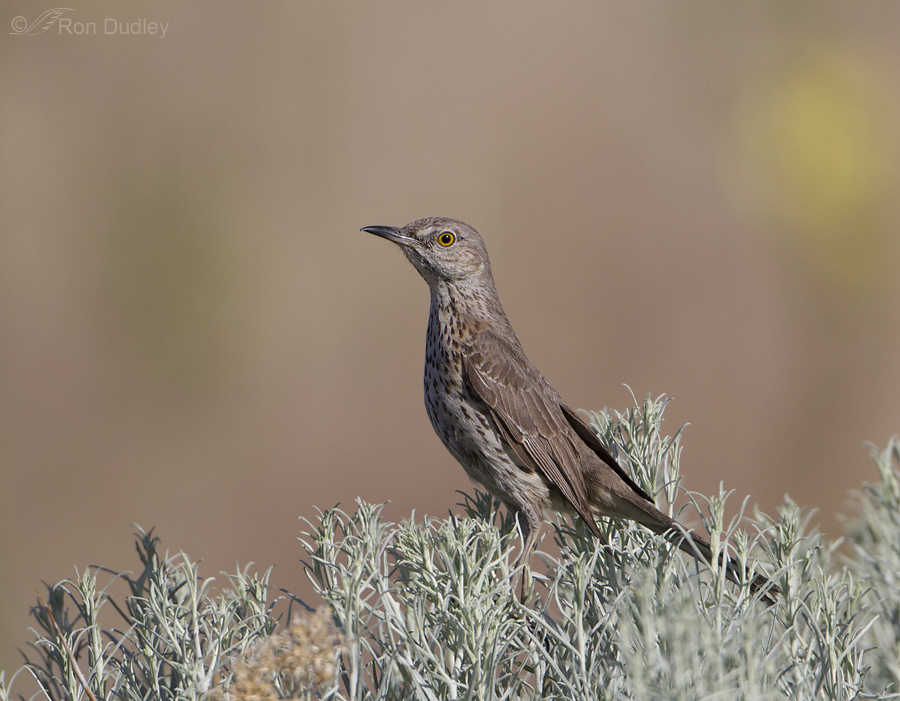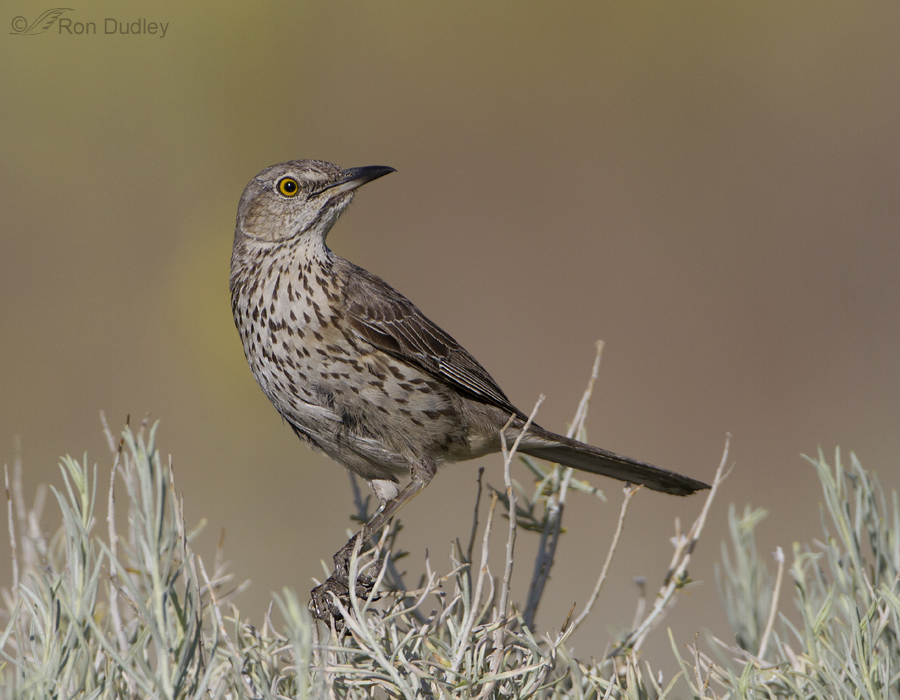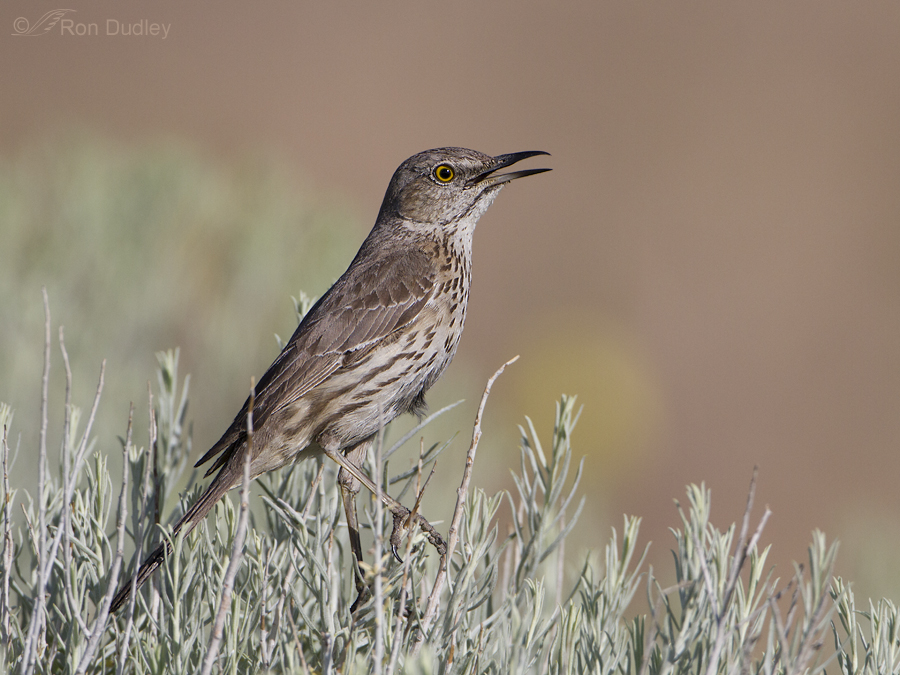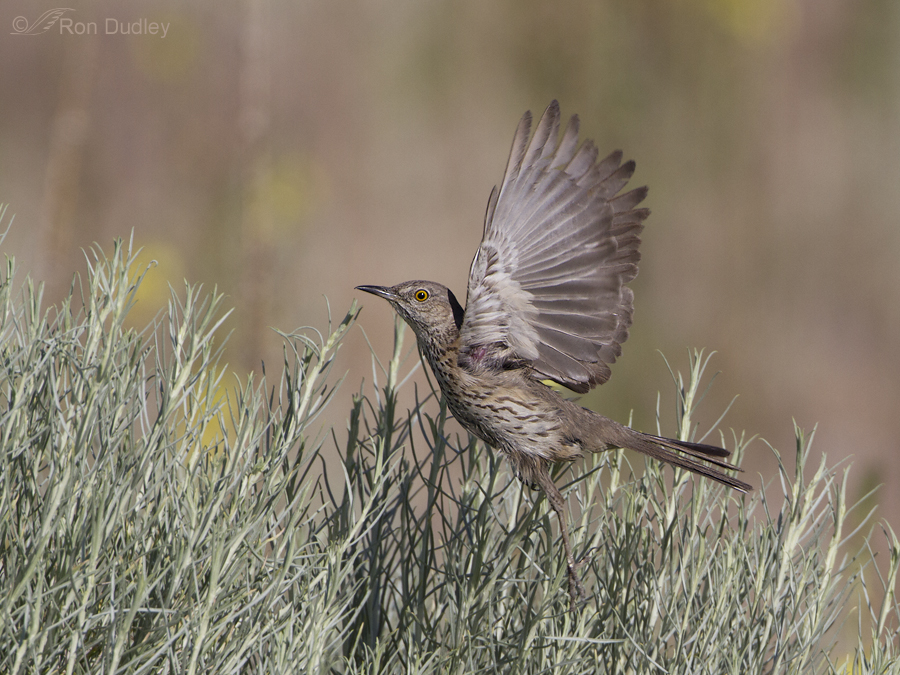Note: when I first published this post my title indicated that this bird is perched on sagebrush. It isn’t – it’s rabbitbrush or rabbit bush (though there was lots of sagebrush nearby). Hate it when I do that! Thanks for the heads-up, Mia.
Though there’s a fair number of Sage Thrashers on Antelope Island they’ve been a difficult quarry for me. Originally called the Mountain Mockingbird, this smallest of the thrasher species is known to be particularly elusive, frequently running on the ground rather than taking flight and their wandering habits during migration have caused them to be poorly studied.
Yesterday morning I found an unusually cooperative thrasher on the island.
This species is considered to be a “sagebrush obligate”, meaning that it is largely dependent on expanses of sagebrush in order to breed successfully and that’s precisely the habitat this bird was occupying, though this particular perch is rabbitbrush. It may have had a nest in the area as it repeatedly popped up onto the tops of several nearby perches as I was parked alongside the road.
The yellow in the background in each of these four images is the ubiquitous moth mullein, a wildflower that covers many of the island hillsides this time of year.
This bird came in too close for my 500 mm lens more than once – a refreshing change from my typical experience with this shy species.
One time it broke out into its soft and melodious, flute-like song. Sage Thrashers can be marathon singers with their song often lasting several minutes without interruption (think about that!). In one Idaho study the average duration of a song bout was 2 minutes and 46 seconds but one bird sang for an amazing 22 minutes!
Here’s a link to the song of the Sage Thrasher if you’d like to hear it.
I tried to get some take-off shots as the bird flitted from perch to perch – this one was my best result.
Later in the summer juvenile Sage Thrashers are easier to approach than the typical adult so I have hopes of more success with the species then.
Ron






I love that final shot. Beautiful – and thank you.
Absolutely wonderful series of photos. I really enjoy the curve-billed thrashers we have. Out at Hueco Tanks we’ve had the pleasure of listening to a Crissal thrasher singing – it is very melodious and pleasant to listen to. I may have seen a sage thrasher on the bird walk we went on in the park, but it was from a distance, so I really appreciate seeing excellent photos of this bird.
What a nice close-up you got. The Thrasher we get in P.R. is the Pearly-eyed Thrasher (a neo-tropical species). It’s been labeled as a “super coloniser” by eBird, and no one can tell how it came to P.R., but it displaced the critically endangered Puerto Rican Parrot (Amazona vittata) by invading the endemic parrot’s nesting cavities. It will invade just about any nesting cavity or nest and even eat their young. It’s a much larger Thrasher than this one, but I wonder if North American Thrashers can get as aggressive as our Caribbean have?
I’m unaware of our thrashers being particularly aggressive, Maria. I just looked up your Pearly-eyed species – neat eye and very thick bill for a thrasher.
I suppose this drastically agressive behavior is more noticeable on a small island, where there is much less competition than on a continent. These ‘super colonisers’ are very adaptable and opportunistic if the conditions are favorable. The native Puerto Rican parrot stands very small chances of true recovery, according to our statistics. It simply could not prevail with this Thrasher and the introduced Mongoose, quite some years ago already.
I have also changed my views since I wrote that post about the Thrasher. I now believe that it’s no necessarily humans’ errors that introduce exotic species in different countries, although deforestation is a human error. I now also believe climatic changes provoke circumstances in which introduction by other means could be a possibility.
Great clarity, beautiful images! We have curved bill thrashers where we live, cool birds.
I’m envious of your Curved-bill Thrashers, Cindy. A friend photographs them fairly regularly but I’ve never seen one.
Great shots Ron!
I’m currently studying Sage Thrashers and other sagebrush-obligate birds in Wyoming, and your description of the thrashers’ elusiveness is spot on! Part of what we do is monitor nests, and its not uncommon for us to observe a nest where the eggs hatch and nestling grow and fledge (a 2-3 week process)–all without ever glimpsing the adults near the nest. Elusive indeed.
Jason
Jason, thanks for the confirmation of their elusiveness. I’m glad to hear that their avoidance of me isn’t to be taken personally!
I read recently that one of the puzzling aspects of Sage Thrasher ecology is the fact that many sagebrush obligates like Brewer’s Sparrow, Sage Sparrow and Sage Grouse are declining while Sage Thrashers are not. Perhaps your research is addressing that question?…
Wow! Just fantastic shots Ron! Of course, I’ve never seen one but I love thrashers and thisone is wonderful! Thanks for sharing!
Charlotte
Thank you, Charlotte.
Hi Ron,
I love your blog, particularly the combination of wonderful imagery and informative text. I am the director of Hawks Aloft, Inc. in Albuquerque and have shared links to some of your blogposts on our Facebook page, always with full credit to you. Is this an acceptable use of your posts. I only did so because of the Facebook link on your posts. Please advise.
Thanks,
Gail
Thank you, Gail. And yes, sharing my posts on FB is perfectly acceptable and I appreciate it. I visited your website (http://hawksaloft.org/) the first time you commented here and I applaud the efforts of Hawks Aloft in preserving New Mexico’s birds and habitats.
Thanks Ron!
What an interesting eye this bird has…also like how clearly you can see the pattern of growth on the cheek feathers, esp. in the second frame. This kind of detail is particularly valuable to any wildlife artist thst wants to get things right. Like the soft yellow blurs of the mullein, too.
I’m glad you appreciate the detail, Patty – that’s one of the visual treats you can get when you’re close to the subject with a quality lens. Thank you.